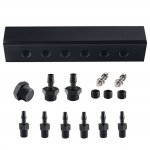Claviger
Aspiring Student
- Joined
- Jul 25, 2014
- Messages
- 6,934
- Location
- Olympia Washington
- Ride
- '21 Z H2, '14 R3R, '02 Daytona 955i
So after a few years playing with PC-V and TuneECU, I've come to recognize a problem, exacerbated by the big cams in my bike. The fuel table using throttle position vs RPM isn't granular enough to really perfectly tune the low throttle position parts. Most of the time when riding legal speeds, the Rocket will be at 0-5% throttle position, with a lot of time at 1% and 3%. The problem with that, is the PC-V table only has 0,2,5 percent columns. How do you add granularity? Use a pressure based table because you can make it as granular as you want. Here is how:
On my 2014 Roadster, the wires coming from the MAP sensor are:
Pink - Reference voltage to sensor
Pink Black Tracer - Ground
Pink Green Tracer - Signal wire
Tap the signal wire and run it to the "Analog input" on the PC-V.
Enable the Pressure Sensor and add your voltage to MAP relationship. For my sensor the values were:
4.05 Volts = 997 HPA
2.44 Volts = 590 HPA
PC-V will interpolate and make a voltage > value relationship (it's hidden you can't see it) based on the values you input allowing it to read outside of those two points.
To get your sensor's values, connect TuneECU and go to "Diagnostics". On the left, look at "Barometrics" with the ignition on, but the engine off, you'll see a value and two voltages something like the below
997 4.04 4.05
The 997 is the hpa, the first voltage 4.04 is the sensor located under the seat, the second voltage is the one you want to use, its the MAP sensor voltage.
Write down the hpa and MAP sensor voltage with the engine off.
Start the bike and look again, the MAP sensor voltage will swing around a bit, but the most frequently seen voltage at idle is the one you use, mine occasionally swung from 2.44 to 2.6 or 2.8, but 2.44 was the correct voltage.
Inside PC-V software go to "Map Tools" > "Pressure Tables" > Add Fuel Table.
It will bring up a window asking for "Table Size" set this to 20. Here are the PSI conversions for the stock TuneECU columns in the L-Tables, I suggest doing this to make it easy to mentally transpose and adjust the base TuneECU tune if you want to do that.


Now that you've the table made, you can go to "Map Tools" then "Advance/Demote Map" then down to the autotune area and set it to "Pressure" instead of "TPS". This will allow it to tune via pressure instead of TPS and use a far far more granular table to adjust your tune.
For a forced induction bike, just extend the pressure table from 20 to 30 and keep adding pressure until the 2nd to last vertical column is your expected max boost, then make one more column with your expected max +5 psi, just in case of overboost situation.
On my 2014 Roadster, the wires coming from the MAP sensor are:
Pink - Reference voltage to sensor
Pink Black Tracer - Ground
Pink Green Tracer - Signal wire
Tap the signal wire and run it to the "Analog input" on the PC-V.
Enable the Pressure Sensor and add your voltage to MAP relationship. For my sensor the values were:
4.05 Volts = 997 HPA
2.44 Volts = 590 HPA
PC-V will interpolate and make a voltage > value relationship (it's hidden you can't see it) based on the values you input allowing it to read outside of those two points.
To get your sensor's values, connect TuneECU and go to "Diagnostics". On the left, look at "Barometrics" with the ignition on, but the engine off, you'll see a value and two voltages something like the below
997 4.04 4.05
The 997 is the hpa, the first voltage 4.04 is the sensor located under the seat, the second voltage is the one you want to use, its the MAP sensor voltage.
Write down the hpa and MAP sensor voltage with the engine off.
Start the bike and look again, the MAP sensor voltage will swing around a bit, but the most frequently seen voltage at idle is the one you use, mine occasionally swung from 2.44 to 2.6 or 2.8, but 2.44 was the correct voltage.
Inside PC-V software go to "Map Tools" > "Pressure Tables" > Add Fuel Table.
It will bring up a window asking for "Table Size" set this to 20. Here are the PSI conversions for the stock TuneECU columns in the L-Tables, I suggest doing this to make it easy to mentally transpose and adjust the base TuneECU tune if you want to do that.
Now that you've the table made, you can go to "Map Tools" then "Advance/Demote Map" then down to the autotune area and set it to "Pressure" instead of "TPS". This will allow it to tune via pressure instead of TPS and use a far far more granular table to adjust your tune.
For a forced induction bike, just extend the pressure table from 20 to 30 and keep adding pressure until the 2nd to last vertical column is your expected max boost, then make one more column with your expected max +5 psi, just in case of overboost situation.


